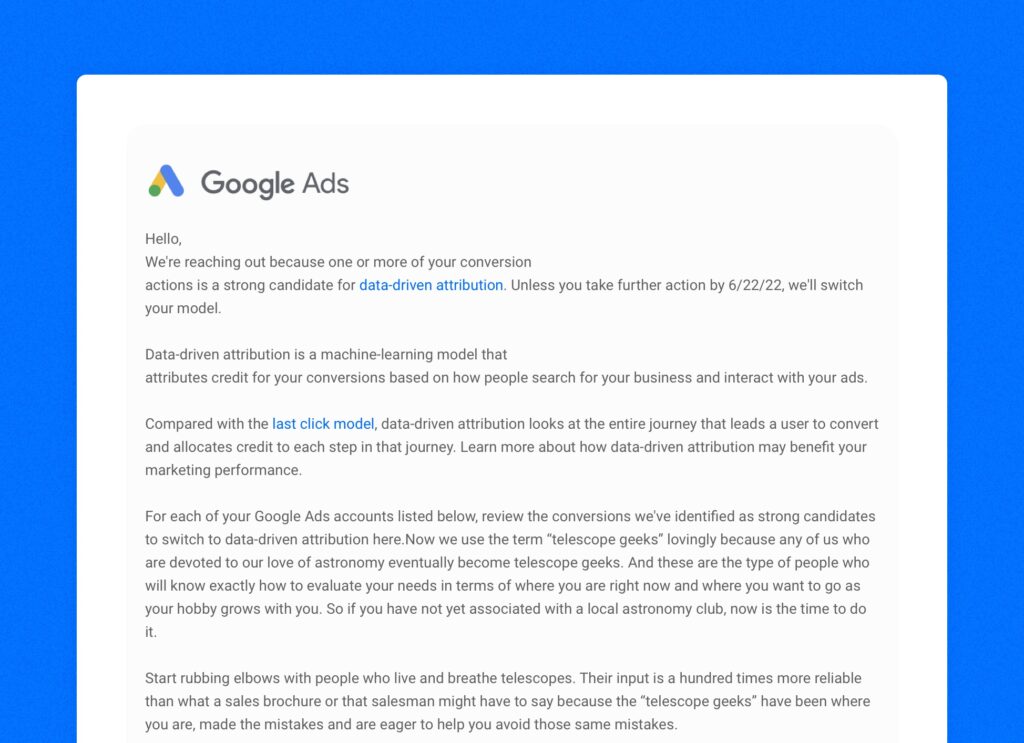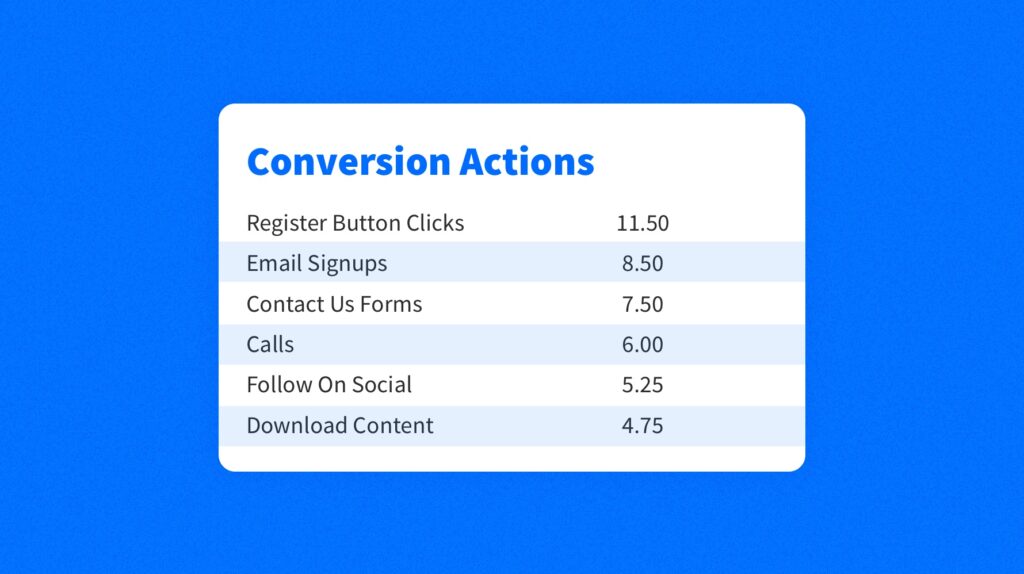Have you or someone from your company recently flagged one of Google’s emails alerting them that your Google Ads account’s conversion actions have been switched to a data-driven attribution model? It was probably an email that looked similar to this:
By the time this article is published, this update has already occurred within all Google Ad accounts. But if you are confused or worried about what this means, don’t be — it’s potentially a great thing for your business. Here’s why.
First off, what the heck are attribution models?
Let’s quickly begin with the basics of what attribution is and the model options Google provides.
Google describes attribution as a conversion path, and on that conversion path, “customers may interact with multiple ads from the same advertiser. Attribution models let you choose how much credit each ad interaction gets from your conversions.” And, for the record, Google signaled the shift toward this model a year ago.
Depending on your business model and the purchasing journey of your customers, you may want to consider a longer time horizon for measuring ad effectiveness. For example, if you’re running a SaaS company we all know how long it takes from the point of the decision maker’s research to become an actual signed client.
The 6 types of Google Ads attribution models
- Last click: Gives all credit for the conversion to the last-clicked ad and corresponding ad or keyword.
- First click: Gives all credit for the conversion to the first-clicked ad and corresponding keyword.
- Linear: Distributes the credit for the conversion equally across all ad interactions on the path.
- Time decay: Gives more credit to ad interactions that happened closer in time to the conversion. Credit is distributed using a seven-day half-life. In other words, an ad interaction 8 days before a conversion gets half as much credit as an ad interaction 1 day before a conversion.
- Position-based: Gives 40 percent of credit to both the first and last ad interactions and corresponding keywords, with the remaining 20 percent spread out across the other ad interactions on the path.
- Data-driven: Distributes credit for the conversion based on your past data for this conversion action. It’s different from the other models, in that it uses your account’s data to calculate the actual contribution of each interaction across the conversion path. The “Data-driven” model is the default attribution model for most conversion actions.
In other words, Google is providing advertisers and business owners options for how they’d like to credit their conversions. Do you only want to count a conversion if that last click was on an ad? Or, would you prefer to evenly spread conversion credit across the user journey?
With attribution models, we have the flexibility to choose. And this flexibility to decide can have significant impacts on your company’s data and business intelligence capabilities. Let us show you how.
Until now, were you ever curious why you saw fractions of conversions within your reporting data?
Have you ever looked through your Google Ads reporting and been confused why you were seeing a percentage of a conversion? How does one 0.50 click on a button? Or download a piece of content .75 times?
The answer lies within the above attribution models.
Google is rewarding campaigns fractions of a conversion depending on the attribution model they’re using.
For example, first or last click attribution models will only receive round numbered conversions because the conversion credit is only attributed to the first or last ad interaction (and nothing in between).
But, if we were using a data-driven model we may see a .75 content download because our ads guided the user on their journey to making that decision. This then provides valuable data that we otherwise would have missed out on if we were using first or last click attribution.
Data-driven attribution allows you to uncover the touchpoints along a user’s conversion journey.
How many digital touchpoints does it take for a user to convert in 2022?
Google released a recent study that showed today’s consumers may experience 20-500 touch points on their purchasing journey.
With the abundance of information available today combined with new ad formats, we’ve seen purchasing journeys extend and become even more complicated.
Therefore, having an understanding of how users purchase or digitally interact with your business can really depend on the attribution model you’re filtering your data through.
So, what attribution model makes the most sense for your business?
This is quite the popular question we’re receiving from clients as of late. There’s a bunch of attribution model options, so which one should you choose for your business?
Our team here at Electric Kite strongly believes that we should never be using a first- or last-click attribution model and advise against these for all of our clients.
Considering a user in today’s environment takes roughly 20-500 touch points to convert, we’d be selling our efforts short and missing out on key insights by using those models.
Here’s why:
Let’s say for example you’re running a SaaS business or a similar style business where a user needs to do some product research. A lot of users researching SaaS products are likely price shopping and getting a better understanding of the marketplace options.
Now, let’s say we’re using last-click attribution and we just brought in a qualified net new user from one of our Google Ads who’s never heard of our brand prior to clicking on our ad.
This person is a qualified lead. They’re a decision maker. They’re a person who can get a contract signed and push this deal through. And we just got them onto our site from one of our search ads.
On their first experience on your website they browsed some content, got what they were looking for and exited the site. They’re impressed with your business, but had to run to a meeting and could not submit for a product demo.
It’s now the end of the following week and this person needs to get the ball rolling on this project. Remembering the brand from their first experience this user then travels directly to your site because the browser history remembers the URL. They submit a product demo and go on to become a sales-qualified lead (SQL), without ever having been categorized as marketing-qualified lead (MQL). Why?
Because last-click only gives credit to the “last-click”.
That person converted and found out about your business from your search ad, yet we see zero conversions in our data. Therefore, whatever keywords, ad copy, landing page, ad type, bidding method — literally any insight as to what brought that user in or converted them is now lost.
This is why we recommend data-driven attribution in 99 percent of scenarios. We spend significant capital on our client’s behalf and the last thing we want to do is look at data through the lens of a first- or last-click attribution.
If we can drive home any point, it’s the importance of understanding the attribution model you’re using and how that impacts your data, business insights and ultimately your bottom line.
Hopefully this was a helpful read for you. If you have any questions about attribution or analytics in general, our paid media team would be happy to help answer any questions.






